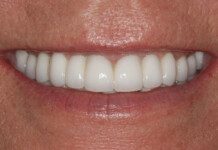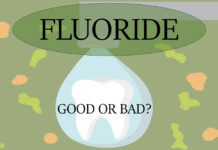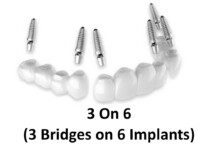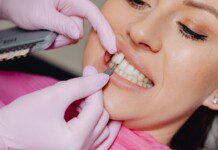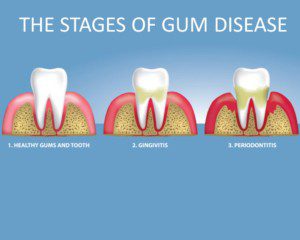
GINGIVITIS is a common and mild form of gum disease (periodontal disease) that is mainly the result of infections and inflammation of the gingiva, the part of your gum around the base of your teeth. The gums can become swollen and red, and they may bleed. Because gingivitis is usually painless and has very mild symptoms, many people who have it are unaware of it.
It’s important to take gingivitis seriously and treat it promptly, before it advances into periodontitis.
Is gingivitis curable and preventable?
Gingivitis can be prevented, and existing gingivitis can be reversed, with good oral hygiene and a bit of help from your dentist and dental hygienist.
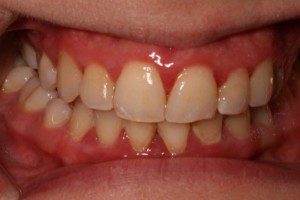
How to cure gingivitis:
- Brush your teeth 2x a day, using a soft-bristled toothbrush to gently brush around each tooth.
- Floss your teeth once a day. Plaque can hide between teeth where toothbrush bristles can’t reach well.
- Use a fluoride rinse.
- See your dentist and hygienist every 6 months
- Avoid ingesting a lot of sugary foods and beverages.
PERIODONTITIS (pair-e-o-don-TIE-tis), commonly referred to simply as “gum disease”, is a serious gum infection that damages the soft tissue and, without treatment, will destroy the bone that supports your teeth. It can cause teeth to loosen or lead to tooth loss. Periodontitis is common but largely preventable.
Symptoms include swollen, red, tender gums, and bleeding gums. Sometimes, gum ulcers will also be present.
Advanced gum disease, which is also referred to as periodontitis, cannot be completely cured. However, it can be treated, to minimize the severity and effects it has on your teeth and bone. Therefore, it’s highly important for patients to implement a maintenance treatment plan to protect themselves against rapid advancement of this disease, which eventually leads to tooth loss. It’s also a risk factor for heart and lung diseases.
Scaling and root planning, followed by regular periodontal maintenance visits can help maintain a healthier oral microflora, and help avoid some of the more serious side effects, such as receding gums, bone loss, and eventually, tooth loss.
Advanced Periodontitis can cause your breath to smell like sulfur or rotten eggs. This is because of the bacteria in your mouth releasing chemicals that smells like these things. Unfortunately, some people don’t admit to themselves there’s a problem until this phase of disease is reached. So, if your gums are red, or bleed easily when you brush or floss, or if you notice the gums receding, see a dentist right away to have your teeth and gums checked.
Can teeth be saved with periodontal disease?
Saving teeth from periodontal disease is possible if you detect the signs and symptoms early and regularly visit your dentist for cleanings and exams. If the condition progresses unhindered, tooth loss should be considered as an eventuality.
Does periodontal disease show on an x-ray?
Taking x-rays is part of the periodontal disease diagnosis process. When we evaluate your gum health, we use x-rays to check how much jawbone you have surrounding each tooth. Since the bone is what keeps your teeth secure, bone loss is an indication of periodontitis, which is a serious oral infection.
What are we doing when we probe around each tooth, calling out numbers?
This is called periodontal charting. We are measuring the depth of the pocket around each tooth; the depth at which the gum ligament is attached to the tooth.
In a healthy mouth, the pocket depth is usually between 1 and 3 millimeters (mm). Pockets deeper than 4 mm are indicative of periodontitis. Pockets deeper than 5 mm cannot be cleaned well, no matter how diligent your homecare routine is.
As part of the periodontal maintenance plan, we will periodically do this periodontal charting, as well as taking x-rays, to monitor bone loss.
Treating gum disease without surgery
- Scaling and Root Planing (often referred to as a ‘deep cleaning”). The goal in the treatment of gum disease is to rid the teeth and gums of pathogenic bacteria and the toxins they produce, which cause the bone and soft tissue damage. Just having Root Planing once does not cure this permanently. Why not? Well, these harmful microbes recolonize at an interval of approximately 3 months, which is why the 3-month periodontal maintenance visits are recommended. We are able to get deeper down into the pockets around the teeth, where these microbes live, and your toothbrush, floss and water pik cannot reach. If we remove them before they recolonize, we can keep the damage at bay and prevent bone and tooth loss.
- Antibiotics/Antimicrobials. (Occasionally, and only in some cases; not routinely.)

If you are diagnosed with gum disease, we will work with you to create a thorough plan on how to best treat and then maintain this for the level of severity you have. (There are varying levels, requiring different maintenance protocols).

